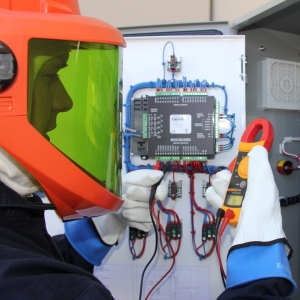Author: Rachelle Gordon, Operations & Safety Coordinator, Jensen Precast
Picture this – it’s 4 in the afternoon, and a field technician is finishing the last few points on his field service checklist. As he opens the control panel, the sound of a nearby car alarm distracts the technician and the screwdriver in his hand accidentally crosses over the 3 live phases inside the panel. Within fractions of a second, the technician is completely engulfed in a cloud of flames hotter than the surface of the sun and thrown back from a blast pressure strong enough to demolish a concrete structure, while simultaneously being pelted with molten metal. The outcome of this horrifying scenario can go one of two ways. If the technician was wearing properly rated Arc Flash protective equipment, he has an extremely high probability of walking away from this incident with only minor injuries. If not, he is likely to suffer from third degree burns from the flames and heat alone, further burning from melted clothing and molten metal fragments, and hearing loss – if he even survives the incident at all.
Every day there are 5-10 arc explosion occurrences in the United States, and these numbers only include incidents where the victim requires treatment from a special burn unit – NOT incidents of less severe injury due to electrical shocks. Keep in mind it is not necessary to touch live components to sustain an arc flash injury.
If there are so many cases of electrical injury happening daily across the US, why isn’t there more concern for worker safety in the pump station industry? Well, it’s easy to forget about the large electrical component associated with pump stations. As with many products in life, we are typically more concerned with the output and attributes thereof – performance levels, speed, efficiency, capacity, etc. We are less concerned with how it works, or what it takes to get it to work – just as long as the product works as intended or better.
Most pump stations are powered by 460V of incoming power, and while that may be what’s feeding into the station’s control panel, the voltage from the main power source could be significantly higher (even more so the closer the station is to a major industrial power source). Our energy consumption today is 300% higher than is was 50 years ago, meaning that we’re also producing much higher volumes of energy than ever before, which means potentially higher voltage and higher risks.
In many instances the only thing separating the energy between the source and the panel are simply a few circuit breakers. If those breakers fail, that panel has suddenly become super charged and any individual performing work is now potentially unaware of an even greater risk of electrical hazard than what they were already facing at 460V.
What can we do to reduce the risk? Awareness, education, and training are at the foundation of preventing injury from any type of hazard. The National Fire Protection Agency (NFPA), The Institute of Electrical and Electronics Engineers (IEEE), and OSHA are all excellent resources for training material, statistics, and safety codes related to Arc Flash and other electrical hazards.
Adapting the correct mindset is a leading factor in preventing injury, saving lives, and helping stop the “it won’t happen to me” attitude. Lastly, investment in properly rated PPE for the work environment is absolutely necessary.
At Jensen Pump Stations, we’re constantly continuing to develop the best operating procedures that are both safe and practical because, really, maintaining safety culture is an endless journey. There is no final stage of ultimate safety completion, and while all of our staff are fully trained in the hazards and proper work practices of electrical power sources, we continue to work on expanding that awareness through toolbox talks and refresher training sessions. Thankfully none of our staff have experienced any major electrical incidents over the last 7 years of operation and we intend to keep it that way.
If safety is something you need help engineering into your next pump station design, please call us toll free at (855) 468-5600 or email us – PumpStations@JensenPrecast.com.
Resources:
https://www.osha.gov/dte/grant_materials/fy07/sh-16615-07/arc_flash_handout.pdf




